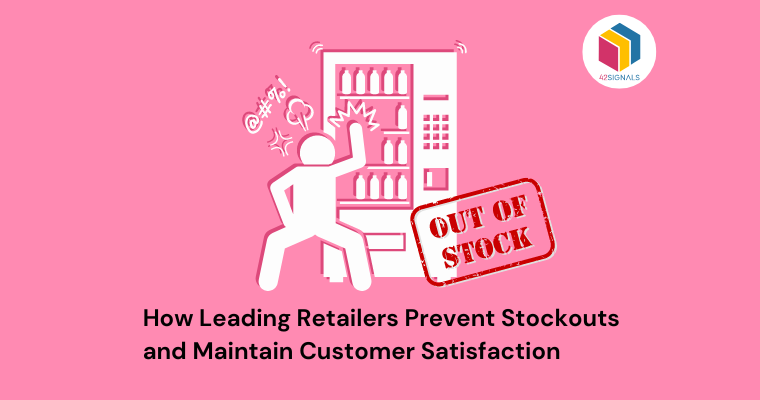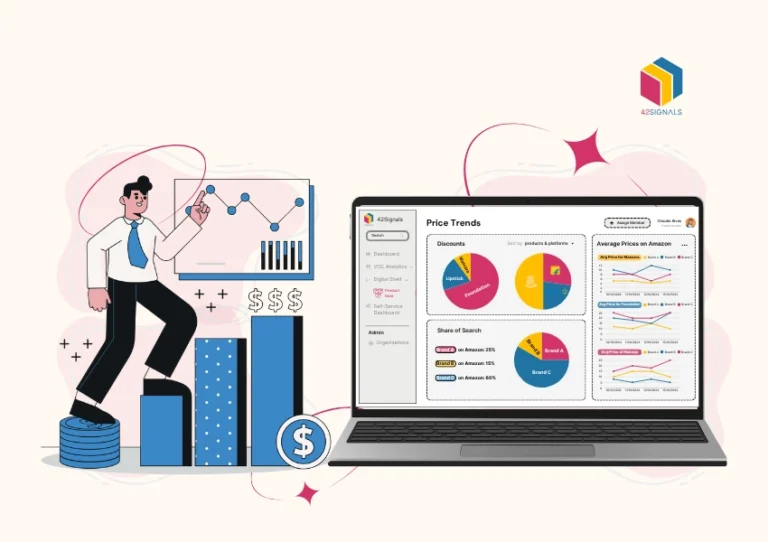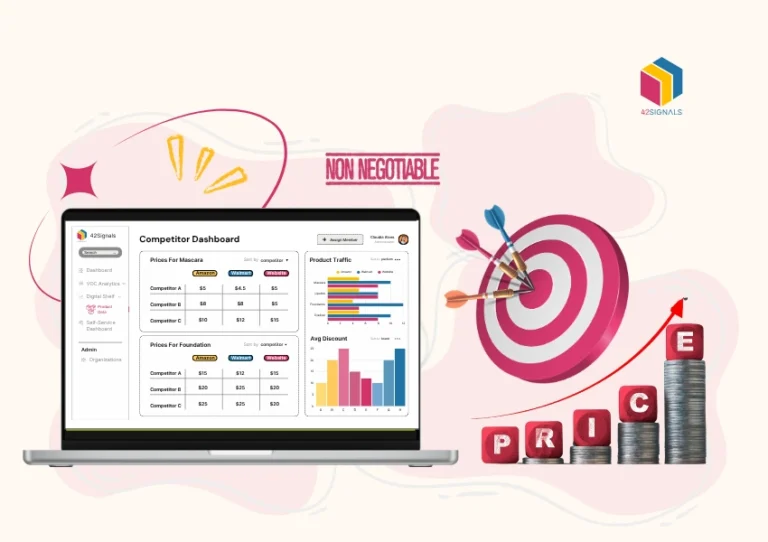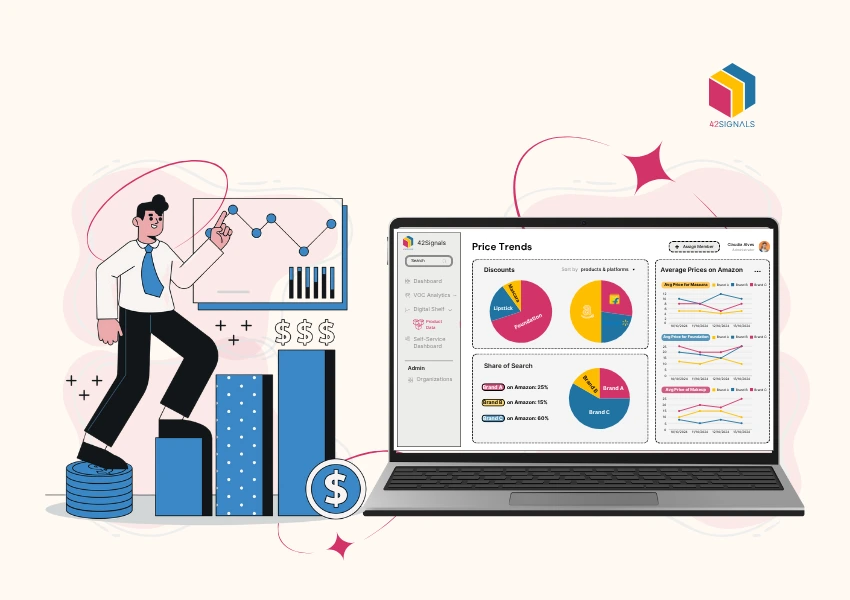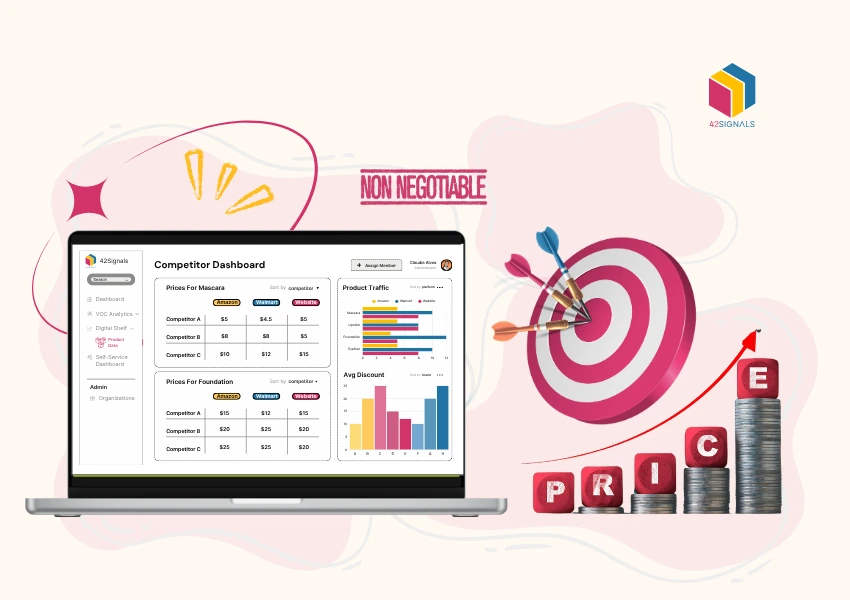Table of Contents
ToggleWith consumer expectations continuously rising, even a single instance of a stockout—a situation where products are unavailable when a customer wants to purchase—can have significant repercussions. Stockouts not only result in immediate lost sales but also impact long-term customer loyalty and brand reputation.
Leading retailers have recognized this challenge and have implemented innovative strategies to prevent out-of-stock situations and maintain high levels of customer satisfaction.
Let’s look at the different methods retailers use via a case study format, the role of digital tools like tracking ad spending, and the importance of quick commerce in this context.
How Stockouts Impact Business Performance?
Before exploring the strategies used to prevent out-of-stock situations, it’s crucial to understand why they are so detrimental. Stockouts disrupt the customer experience, leading to frustration and disappointment.

Image Source: Geeks for Geeks
When a customer encounters a stockout, they may switch to a competitor, reducing the retailer’s market share. Moreover, repeated out-of-stock situations can tarnish a retailer’s reputation, leading to negative reviews and a decline in customer loyalty.
In addition to the immediate financial impact, they also affect a retailer’s marketing efforts.
For example, consider the concept of Return on Ad Spend (ROAS), which is a critical metric for evaluating the effectiveness of advertising campaigns. ROAS, meaning the ratio of revenue generated to the cost of advertising, is negatively impacted by stockouts.
Even if an ad campaign successfully drives traffic to a product page, a stockout renders these efforts fruitless, as customers can’t complete their purchase. Understanding ROAS calculation and what ROAS is is essential for retailers looking to optimize their ad spend and maximize revenue.
Strategies to Prevent Stockouts
1. Advanced Inventory Management Systems
Moving far beyond simple spreadsheets and periodic stock counts, cutting-edge inventory management systems (IMS) are the cornerstone of modern retail resilience. These platforms leverage sophisticated algorithms and artificial intelligence (AI) to transform raw data into actionable intelligence for optimal stock positioning.
Beyond Amazon & Walmart: While giants like Amazon (with its anticipatory shipping patents and vast demand-sensing network) and Walmart (leveraging massive data lakes for hyper-local forecasting) are pioneers, the technology is increasingly accessible. Fast-fashion retailers like Zara use highly responsive IMS tightly integrated with their design and manufacturing, enabling rapid inventory turnover based on real-time sales data. Grocery chains utilize it for perishable goods, optimizing order quantities to minimize waste and maximize freshness.
Real-Time Visibility & Granular Tracking: Modern IMS integrates with Point-of-Sale (POS) systems, warehouse management systems (WMS), RFID tags, and IoT sensors to provide a single, unified view of inventory across every node in the supply chain – from the manufacturer’s floor to the store shelf or fulfillment center bin. This granularity allows for tracking individual SKUs in real-time, instantly reflecting sales, returns, transfers, and damages. Image Source: Advotics
Demand Forecasting Powered by Machine Learning (ML): The true power lies in predictive capabilities. ML algorithms ingest vast datasets, far exceeding simple historical sales.
- Historical Sales Data: Seasonality, trends, baseline demand.
- Market Intelligence: Competitor pricing and promotions, emerging trends, social media sentiment analysis.
- External Factors: Local events, weather forecasts (crucial for categories like apparel, beverages, or seasonal items), economic indicators.
- Promotional Impact: Predictive modeling of how planned marketing campaigns, discounts, or featured placements will spike demand.
- Causal Factors: Identifying relationships between seemingly unrelated events (e.g., a heatwave increasing sales of specific beverages and sunscreen). These models, often using techniques like ARIMA, exponential smoothing, or neural networks, generate highly accurate demand forecasts at the SKU-location level days, weeks, or even months in advance.
- Automated Replenishment & Optimization: Based on the forecast, current stock levels, defined service level targets (e.g., 98% in-stock rate), lead times, and storage constraints, the system automatically generates optimized purchase orders or transfer requests. It dynamically adjusts safety stock levels, minimizing excess inventory while creating a robust buffer against demand variability and supply chain delays. Systems can also factor in cost optimization, suggesting the most economical order quantities and timings.
- Cloud-Based Agility & Scalability: Leading solutions are cloud-native, offering scalability, easier integration with other systems (ERP, e-commerce platforms), and accessibility from anywhere. This facilitates rapid deployment of updates and access to the latest AI/ML innovations.

Image Source: Advotics
These systems help retailers maintain optimal inventory levels, reducing the risk of stockouts.
For instance, retailers like Amazon and Walmart use machine learning models to forecast demand and adjust inventory levels accordingly.
These models consider various factors such as past sales data, promotional schedules, and even weather patterns. By accurately predicting demand, these retailers can ensure that popular products are always in stock, thus avoiding potential out-of-stock situations.
2. Omnichannel Fulfillment Strategies
The rigid separation between online and physical store inventory is obsolete. Omnichannel fulfillment is about erasing these boundaries, creating a fluid network where inventory anywhere can satisfy demand anywhere. This dramatically increases inventory utilization and drastically reduces location-specific stockouts.
- The Core Principle: Unified Inventory Pool: The foundation is a central inventory management system that sees all inventory – distribution centers, stores, in-transit shipments, even vendor-managed inventory – as a single, fulfillable pool. This “endless aisle” concept is powered by robust Order Management Systems (OMS).
- Key Fulfillment Models Enabled:
- Buy Online, Pickup In-Store (BOPIS / Click & Collect): Allows customers to reserve online and collect locally, often within hours. If the local store is out of stock, the system can fulfill from another nearby store or a DC.
- Ship-From-Store: Turns physical stores into micro-fulfillment centers. When the online warehouse is low on an item, orders can be routed to a store with available stock, leveraging that inventory for broader geographic reach and faster, cheaper last-mile delivery.
- Reserve Online, Pay & Pickup In-Store: Reduces the risk of the item selling out before the customer arrives.
- In-Store Kiosks & Endless Aisle: If an item isn’t on the shelf, associates can order it for home delivery or in-store pickup from another location via a store terminal.
- Curbside Pickup: An extension of BOPIS, offering maximum convenience and minimizing stockout disappointment by confirming availability before arrival. Image Source: iThink Logistics
- Operational Challenges & Solutions:
- Inventory Accuracy: Omnichannel is impossible without near-perfect real-time inventory accuracy. This demands robust cycle counting, RFID implementation, and systems that reconcile discrepancies instantly.
- Store Labor & Process: Fulfilling online orders from the store floor requires clear processes, staff training, and potentially designated picking/packing areas to avoid disrupting in-store shoppers.
- Dynamic Routing Logic: The OMS must intelligently route orders based on real-time stock, proximity to customer, cost to fulfill, and delivery speed promise. Algorithms weigh factors like store workload and delivery capacity.
- Returns Management: A seamless returns process across channels is essential for customer trust.
- Success Story – Target: Target’s massive investment in its stores-as-hubs strategy is a textbook example. Leveraging its dense store network, it fulfills over 95% of its online orders through stores, enabling same-day services (Drive Up, Order Pickup, Shipt delivery) and dramatically reducing the risk of online stockouts by tapping into store inventory pools. This integration was a key factor in their ability to manage demand surges during the pandemic.

Image Source: iThink Logistics
By leveraging multiple channels, retailers can better manage inventory and reduce the risk of stockouts.
For example, if a product is out of stock at a physical store, the retailer can fulfill the order through its online inventory.
This approach not only prevents out-of-stock situations but also enhances customer satisfaction by offering flexibility and convenience. Retailers like Target have successfully implemented omnichannel strategies, allowing customers to order online and pick up in-store or have items shipped directly to their homes.
3. Supplier Collaboration and Diversification
Inventory management doesn’t stop at the retailer’s receiving dock. Proactive collaboration with suppliers and strategic diversification are critical defenses against upstream disruptions that cause downstream stockouts.
Balancing Act: Diversification can increase complexity and potentially cost. The key is strategic diversification – identifying critical items and high-risk categories where redundancy is worth the investment, while potentially consolidating sourcing for less critical, stable items to leverage volume discounts.
Deep Supplier Collaboration:
Shared Forecasting (CPFR – Collaborative Planning, Forecasting, and Replenishment): Moving beyond sending purchase orders, retailers share their detailed demand forecasts and promotional plans with key suppliers. Suppliers, in turn, share capacity plans, production schedules, and potential constraints. This two-way transparency allows for joint problem-solving and alignment.
Vendor Managed Inventory (VMI): The supplier takes responsibility for monitoring the retailer’s inventory levels (often via EDI or shared portals) and proactively replenishing stock based on agreed-upon min/max levels and forecast data. This shifts some burden but requires immense trust and data integration.
Supply Chain Visibility: Gaining visibility deeper into the supplier’s own supply chain (Tier 2, Tier 3 suppliers) helps anticipate potential raw material shortages or production delays. Platforms facilitating this multi-tier visibility are becoming essential.
Joint Business Planning (JBP): Regular strategic meetings focusing on category growth, innovation, and risk mitigation, fostering a true partnership mentality. Image Source: Pinterest
Strategic Supplier Diversification:
Mitigating Single Points of Failure: Over-reliance on one supplier, especially one located in a single geographic region, is a massive risk. Natural disasters, political instability, port congestion, or factory-specific issues can cripple supply.
Dual/Multi-Sourcing: Sourcing the same or similar SKUs from multiple suppliers, often in different geographic regions. This requires careful management of specifications and quality control but provides crucial redundancy.
Nearshoring/Reshoring: Bringing production closer to the end market reduces lead times and exposure to complex global logistics disruptions. While often higher cost, the benefits in responsiveness and risk reduction can be significant for critical items.
Modular Sourcing & Component Commonality: Designing products to use common components sourced from multiple suppliers increases flexibility if one component source is disrupted.
Supplier Risk Assessment: Continuously evaluating suppliers based on financial health, operational resilience, geopolitical risk, ethical compliance, and environmental factors.
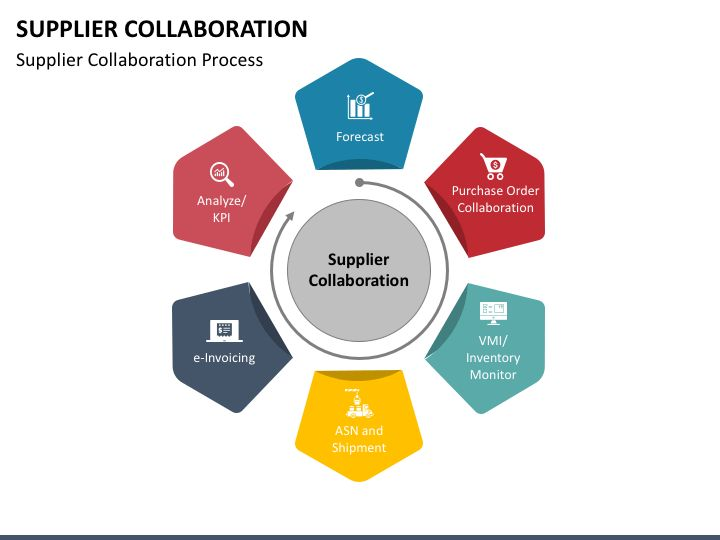
Image Source: Pinterest
Diversifying suppliers is a strategy that reduces the risk of stockouts. Relying on a single supplier can be risky, as can any disruption in the supply chain, such as production delays or shipping issues.
By sourcing products from multiple suppliers, retailers can mitigate this risk and ensure a steady supply of products.
4. Quick Commerce and Real-Time Stock Updates
The rise of quick commerce—a model where retailers promise delivery within a short time frame, often within an hour—has revolutionized the retail industry.
Quick commerce requires retailers to have real-time stock updates and a well-coordinated supply chain to ensure that products are available for immediate delivery.

Image Source: Delivery Hero
Retailers like Instacart and Gorillas have embraced quick commerce, using technology to provide real-time inventory updates.
These retailers use data analytics to monitor stock levels continuously and ensure that their inventory is synchronized across all platforms. This approach not only prevents stockouts but also enhances the customer experience by offering fast and reliable delivery.
How Tracking Ad Spends Enhances Your Marketing Strategy?
Effective marketing is crucial for driving sales, but it must be coupled with adequate inventory management to avoid stockouts.
Tracking ad spending plays a significant role in this context, as it allows retailers to align their marketing efforts with their inventory levels.
By closely monitoring ad spends, retailers can avoid over-promoting products that are low in stock. For instance, if a particular product is running low on inventory, retailers can adjust their ad campaigns to focus on other products that are fully stocked. This approach not only prevents out-of-stock situations but also optimizes the return on ad spend (ROAS).
If a campaign generates high traffic but leads to stockouts, the retailer can analyze the data to adjust future campaigns and improve inventory planning. This iterative process helps retailers refine their marketing strategies and prevent out-of-stock situations, ultimately leading to higher customer satisfaction.
Why Share of Search Matters for Avoiding Stockouts?
Another critical aspect is maintaining a strong share of search—a metric that reflects a brand’s visibility and presence in search engine results relative to its competitors. A high share of search indicates that a brand is top-of-mind for consumers and is likely to drive significant traffic to its website or store.
However, if a retailer’s share of search increases significantly without corresponding inventory levels, it can lead to stockouts.

For example, if a retailer launches a successful marketing campaign that boosts its share of search, but fails to increase its inventory levels accordingly, it may experience items going out-of-stock as demand outstrips supply.
To prevent this, leading retailers closely monitor their share of search and align it with their inventory management strategies. By ensuring that they have adequate stock levels to meet the increased demand generated by a high share of search, retailers can prevent stockouts and maintain customer satisfaction.
Case Study: Zara’s Success in Stockout Prevention
Zara, the global fashion retailer, offers a compelling case study in stockout prevention. Zara has built its business model around speed and agility, allowing it to bring new fashion trends to market quickly while minimizing stockouts.
One of the key elements of Zara’s success is its efficient inventory management system. Zara uses a combination of real-time data analytics and rapid supply chain processes to ensure that its stores are always stocked with the latest trends.

Image Source: Inside IIM
By tracking sales data and customer preferences, Zara can quickly adjust its inventory levels and replenish popular items before they run out of stock.
Zara also leverages a version of quick commerce to enhance customer satisfaction. With its “buy online, pick up in-store” option, Zara allows customers to reserve items online and collect them at their convenience.
This approach not only prevents out-of-stock situations but also provides a seamless shopping experience, leading to high levels of customer loyalty.
Conclusion
Preventing stockouts and maintaining customer satisfaction are critical challenges for retailers in today’s competitive market.
Additionally, by tracking ad spends, understanding ROAS meaning and calculation, and monitoring share of search, retailers can optimize their marketing efforts and align them with their inventory levels.
As the retail landscape continues to evolve, the importance of preventing stockouts and maintaining customer satisfaction will only grow.
To see how 42Signals’ Product Availability and Share of Search tools can help you prevent stockouts and optimize your marketing efforts, schedule a demo with us today.
